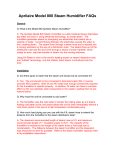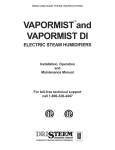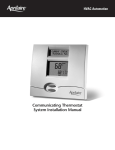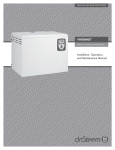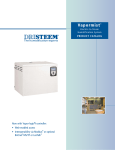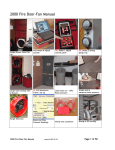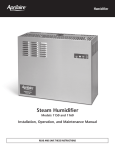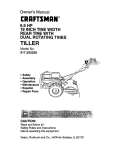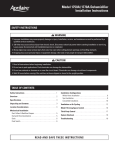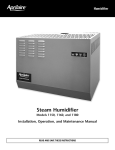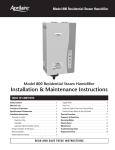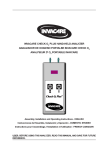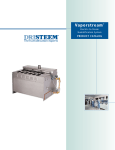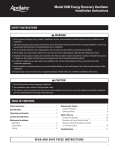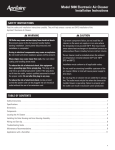Download Aprilaire 850 Specifications
Transcript
Downloaded from www.rsandrews.com. Since 1968, RS Andrews has proudly served Atlanta's Heating, Air Conditioning & Plumbing Needs. Aprilaire Humidifier Application ® REFERENCE GUIDE EXPERIENCE | KNOWLEDGE | TRUST welcome Welcome to Aprilaire Aprilaire, Your Partners In Comfort and leaders in humidification technology for over 50 years offers a complete line of whole-home humidifiers designed to meet the ever increasing needs of today’s consumer. This guide is designed to educate and assist you in selecting the correct humidifier based on the humidification needs of the residence and the HVAC equipment application. Following these simple guidelines will ensure a humidifier installation that operates trouble free and efficiently for years to come, creating satisfied customers. Aprilaire’s customer service department is dedicated to providing the best service possible to our customers. Based at our corporate headquarters in Madison, Wisconsin, our customer service agents average over seven years of industry experience and can resolve most issues on the first call. In providing the best service available to our customers, we aspire to: • Answer all calls in thirty seconds or less • Respond to e-mails within twenty-four hours • Practice first call resolution • Follow up immediately with a definitive answer if a call cannot be resolved immediately We always welcome feedback as we continue to strive for improvement. Customer service agents are available Monday through Friday from 7:00 am through 5:00 pm (CST) and can be reached by phone at (800) 334-6011 or by e-mail at [email protected] TABLE OF CONTENTS Table of Contents 1. 2. 3. 4. 5. 6. The Story of Humidification Selecting a Humidifier Sizing Control Aprilaire Evaporative Aprilaire Steam story of humidity THE STORY OF HUMIDITY The Story of Humidity Humidification – the process of adding moisture to the air – is one of the most important aspects of total indoor comfort, yet it’s one of the least understood. One reason for this is that humidity is an intangible. It can’t be seen, touched, or smelled. It has no color, no sound. However, its presence, when properly controlled, offers many proven benefits. Humidification during the heating season not only provides comfort, it helps protect the home and its furnishings from the harmful effects of air that’s too dry. In addition, physicians often recommend humidity to guard against dry skin, hair, and scratchy throats. It also reduces undesirable winter-time static electricity. Relative humidity (RH) indicates the amount of water vapor, in percent, actually in the air compared to the maximum amount that the air could hold under the same conditions. The warmer the air, the more moisture it can hold. Air in a home heated to 70°F can hold about eight grains of moisture per cubic foot. That is 100% RH. If there are only two grains per cubic foot in the home, this is ¼ of the air’s capacity to hold moisture. Therefore, the RH is also ¼ or 25%. The air could hold four times as much water. But, the important thing is what happens to air when it’s heated. The outdoor-indoor RH conversion chart below illustrates this. OUTDOOR-INDOOR RELATIVE HUMIDITY CONVERSION CHART Example: (See shaded figures) Outdoor RH is 70%; outdoor temperature is +10°F; when this air is brought into the home and heated to 70°F, the indoor RH drops to 6%. (figures in chart are percentages) OUTDOOR RELATIVE HUMIDITY Locate outdoor RH on the left of the chart and outdoor temperature at the bottom. Indoor RH is where the vertical and horizontal columns meet. The calculation assumes that outdoor air is brought into the home and heated to 70°F. 100% 2 4 5 6 7 9 12 17 19 23 29 36 43 52 95% 2 3 4 6 7 9 12 16 17 22 28 34 41 50 90% 2 3 4 5 6 8 11 15 16 21 26 31 39 48 85% 2 3 4 5 6 8 11 14 15 20 24 29 37 45 80% 2 3 4 5 6 7 10 13 15 19 23 27 35 42 75% 2 3 4 4 5 7 10 12 14 18 22 26 33 39 70% 1 2 3 4 5 6 9 11 13 17 20 24 31 36 65% 1 2 3 4 4 5 8 10 12 15 19 23 29 34 60% 1 2 3 3 4 5 7 9 11 14 17 21 26 31 55% 1 1 3 3 4 4 7 8 10 13 16 19 24 29 50% 1 1 2 3 3 4 6 8 9 12 14 18 22 26 45% 1 1 2 3 3 4 6 7 8 11 13 16 20 24 40% 1 1 2 2 3 4 5 7 7 10 12 14 18 21 35% 1 1 2 2 2 4 5 6 6 9 10 12 15 18 30% 0 1 2 2 2 3 4 5 6 7 9 11 13 15 25% 0 1 1 1 2 3 3 4 5 5 7 9 11 13 20% 0 1 1 1 2 2 3 3 4 5 5 7 9 10 15% 0 0 1 1 1 1 2 3 3 4 4 5 6 8 10% 0 0 0 1 1 1 2 2 2 3 3 3 4 6 5% 0 0 0 0 0 0 1 1 1 2 2 2 3 3 0% 0 0 0 0 0 0 0 0 0 0 0 0 0 0 -20 -10 -5 0 +5 +10 +15 +20 +25 +30 +35 +40 +45 +50 OUTDOOR TEMPERATURE (˚F) This substantial reduction of RH from outdoor to indoor air is taking place in every unhumidified or under-humidified home where the air in the home is heated. To solve it, we add moisture artificially, so there’s more water available for that thirsty air to exercise its ability to hold more water. We humidify because there are benefits that are as important as heating to overall indoor comfort and health during the heating season. THESE BENEFITS CAN BE GROUPED INTO FOUR GENERAL CLASSIFICATIONS: • • • • Comfort Health Preservation Energy Conservation Comfort Did you ever step out of your shower in the morning and notice how warm it is in the bathroom? It is actually muggy. It is probably about 75°F, and the RH may be 6070% because of the water vapor being added to the air while showering. If the phone rings and you have to step out into the hall to answer it, what happens? You feel chilly! Yet the temperature there is probably about 70°F. Just 5°F cooler than in the bathroom, yet you are shivering. Why? Because you just became an evaporative cooler. The air in the hall is dry; and the RH can be as low as 10-15%. You are wet, and this thirsty air goes to work on your skin. It evaporates the water, and as it does, your skin is cooled. This same type of thing goes on day after day, every winter, in millions of homes. People are turning their thermostats up to 75°F and more in order to feel warm, and even then, it feels drafty and chilly because the evaporative cooling process is occurring. Proper RH levels make you feel more comfortable at lower thermostat settings. This cold effect is not the only discomfort caused by toodry air. Static electricity is another indication of low humidity levels and a condition that’s consistently annoying. Proper RH will reduce this discomfort. And optimum RH levels can now be achieved without constant manual adjustment of the humidifier control device, using the newest generation of Aprilaire automatic humidifiers. Health Proper RH is helpful for relieving problems aggravated by air that is too dry. Low humidity can make you more susceptible to catching a cold or flu viruses. How? Air that is too dry dries out your nasal membranes and makes the lining of your nose more susceptible to bleeding and infections. Also, low levels of humidity have been linked to the speedier progression and transmission of viruses in the air*. Whole-house humidifiers equipped with automatic control can maintain a proper level of humidity for a healthier and more comfortable environment. What do doctors say about humidity? Ear, nose, and throat specialist, Dr. Arthur W. Proetz, is quoted in the Annals of Otology, Rhinology and Laryngology: “In the struggle between the nose and the machinery in the basement, sometimes the heater wins and sometimes the cooler, but seldom the nose. The nasal mucus contains some 95% of water. To begin with, it is more viscous than mucus elsewhere in the body and even slight drying increases the viscosity enough to interfere with the work of the cilia. Demands on the nasal glands are great even under usual conditions, and they cannot cope with extreme dryness. “Experience has shown that with winter approaching, the first wave of dry-nose patients appears in the office when the RH indoors falls to 25%. It would seem, therefore, that 35% would be regarded as a passing grade but 40% as something to shoot for. Preservation The addition or reduction of moisture drastically affects the qualities, dimensions, and weights of many materials. For example, wood, leather, paper, and cloth all contain water. Not a fixed amount of water, but an amount that will vary greatly with the RH level of the surrounding air. Take, for example, a cubic foot of wood. At 60% RH, the wood will hold over 3 pints of water. Now, if the RH is lowered to 10%, the water held by the wood will not fill even one pint bottle. So we have, in effect, withdrawn 2 ½ pints of water from the wood by lowering the RH from 60% to 10%. * 1. Department of Microbiology, Mount Sinai School of Medicine article, Influenza Virus Transmission Is Dependent on Relative Humidity and Temperature; 2007; New York, New York, United States of America http://www.plospathogens.org/article/info:doi/10.1371/journal.ppat.0030151 2. Oregon State University College of Oceanic and Atmospheric Sciences www.pnas.org/cgi/doi/10.1073/pnas.0806852106 What are the effects of this constantly changing or constantly low moisture content in the air? Furniture construction is affected as glue dries out, joints separate, rungs fall out, and cracks appear. Plaster and drywall dries out, resulting in unsightly cracks and popping nail heads. Joists and studs shrink. Wood paneling separates and cracks. Floors separate. Pianos, organs, and other musical instruments lose their tone. Pieces of art, books, and documents dry out and can break or crack. “ “ ” Energy Conservation Dry air robs the moisture from your skin, making you feel colder, which means you turn up the heat. Dry air also shrinks the framing around doors and windows, resulting in gaps that let in cold air from the outside, making your home less energy efficient. The preservation benefit describes the change in the dimension of wood with a change in the surrounding RH. Heated air dries out and shrinks wood framing around doors and windows. Outside air infiltrates the home at these and additional locations, as a result of wind and chimney or stack effect. Studies suggest approximately 74% of a home’s infiltration occurs at the home’s envelope (perimeter walls, windows, and doors). A published study indicates the framing around doors, windows, etc., will have less shrinkage when the proper inside RH is maintained. Therefore, proper inside RH may reduce infiltration of outside air, because the cracks between the framing and the supporting structure will be reduced. With minimum shrinkage, there is less crackage, reducing infiltration, thus increasing energy conservation. Increasing the humidity of your home helps eliminate the dry air that can irritate and inflame the respiratory passages in the nose and throat and can relieve the discomforts of colds and the flu. – A.D.A.M. Health Encyclopedia ” There is as yet no cure for the common cold. The most important preventative measure would appear to be the proper regulation of the humidity. – Joseph Lubart, MD New York State Journal of Medicine THE STORY OF HUMIDITY This type of action goes on, not only with wood, but with every single material in the home that has the capacity to absorb and release moisture. Paper, plaster, cloth, fibers, leather, glue, skin, and practically everything else in the home shrink as they lose water, and swell as they take on water. If the water loss is rapid, warping and cracking can take place. As the RH changes, the condition and dimensions of the materials change, as constantly as the weather. This is why humidity must be added. This is why RH must be controlled. That is why optimum RH is important. selecting a humidifier Humidifiers are classified as two general types: consumers peace of mind when installed properly; making expensive, time-consuming call backs a thing of the past. • Evaporative-Type Units • Steam-Type Units With precise operation, Aprilaire evaporative and steam humidifiers are designed to perform at your customer’s expectations. There are many humidifier brands that are in the market with varying capacities, controls, and efficiencies. Ease of Maintenance Just as one would maintain their car, a humidifier should have a scheduled maintenance program. Typically, Then there are several criteria one should consider when choosing a whole-home system. These are: capacity, control, operational efficiency, ease of maintenance, and ease of installation. Let’s take a closer look at the things to look for when selecting a humidifier. humidifiers should be checked once a year. Many contractors offer service contracts to help consumers perform this task. Capacity The average-size home requires about eleven gallons of water per day. If the humidifier can’t deliver this much water, it is undersized for most installations and is not recommended. Aprilaire has humidifier models that can produce up to eighteen gallons per day (Evaporative Units) and over twenty-three gallons of water per day (Steam-Type Units). Refer to Sizing section for detailed information. Control There is a direct relationship with capacity and control. If the capacity is not there, you simply cannot reach the RH levels required for comfort. Control is as essential in keeping RH levels low enough as it is in keeping it high enough. An Aprilaire humidifier gives you the ability to not only have the correct capacity, but to also control it both manually and automatically. Operational Efficiency Aprilaire humidifiers operate so that working parts are not affected by the build-up of mineral deposits. They have the ability to maintain RH at the manually set humidistat level but can also do this automatically. Aprilaire humidifiers are engineered to give your Aprilaire humidifiers are designed for simple and easy maintenance. The components are easy to clean or can simply be replaced with new parts saving time and money. Ease of Installation A professional heating and air conditioning contractor can install an Aprilaire humidifier quickly, with little interruption to the customer’s home. Whether it is a plenum-mounted evaporative unit or a steam unit, the installation process for all Aprilaire humidifiers is fast and easy. They are designed to ensure trouble-free operation and high efficiency performance. To summarize, when choosing a humidifier, you want to focus on products that will give your customers peace of mind when making an investment in a humidifier. SELECTING A HUMIDIFIER Selecting a Humidifier Evaporative or Steam Product Selection Evaporative and steam humidifiers are very different in their technologies. Evaporative humidifiers do not heat the water but use hot air flow through a water panel and the HVAC system’s heat draw to turn the water to vapor. Steam humidifiers heat water to the boiling point, producing steam. Both technologies use the system blower to distribute humidity through the ductwork. Steam units can be mounted with a blower pack, if a ducting system is not available. Aprilaire offers a full line of evaporative and steam products. Both technologies are effective at delivering the right levels of humidity throughout the home; however, it’s important that the right product is selected to ensure consumer satisfaction. It is important to understand these considerations when choosing the product for your consumers. Evaporative humidification is the best choice for applications where the unit can be mounted on the duct work. Evaporative products are easier to install, extremely reliable, last the life of the equipment, and offer an attractive consumer price point. Steam products are ideal to fill application gaps where evaporative products can not be installed or do not offer enough capacity. These gaps include lack of duct space on the plenum, attic or crawl space locations, in floor heat, electric strip heat, boilers, hydronic heat and where systems experience short run times. Geographic location of the home can also be an important selection factor in determining which Aprilaire product to choose. In the upper Midwest and Northeast with long, harsh winters that have extended furnace run times and limited demand for humidification outside of a heat call, evaporative products are the primary choice. In the south-central US along the Mason Dixon line where winters are milder and there is a high penetration of heat pumps, and some humidification CHOOSING THE RIGHT PRODUCT FOR YOUR HOUSE is needed beyond a call for heat, either evaporative or steam will work. Recommendation Application In the southwest with mild winters and very little call for heat, but the air is very dry, steam is the primary choice. Home Size Up to 4,200 ft2 tight home Up to 6,200 ft2 tight home Space to mount on duct No freezing concerns Lowest cost to install Other Variables Easiest to maintain Lowest cost to operate Low heating system run-time Heat pump installation Possibility of freezing Cannot mount on duct Evaporative Steam SELECTING A HUMIDIFIER It is important to select the right type of humidification product for your customer based on their individual needs, home structure, and geography of their house. sizing Sizing SIZING Sizing for humidification is similar to sizing for heating and cooling. The humidifier capacity required will be determined by various factors such as: A. The volume of area being humidified B. The air change rate (infiltration or ventilation) C. Humidification load determination A. The volume of area being humidified The volume can be determined from a floor plan or from measurements taken within the home. It’s important to determine the volume, not just the square feet. Care should be taken to determine ceiling height or any open space such as vaulted ceilings. If the basement is heated and ventilated, its volume should also be included. B. The air change rate (infiltration or ventilation) The amount of infiltration was probably calculated when computing the heating and cooling load. AHRI defines structure types as follows: • Tight construction – ½ air changes per hour of air infiltration, well insulated with vapor retarders, tight storm doors, windows with weather stripping. • Average construction – 1 air change per hour of air infiltration, insulated with vapor retarders, loose storm doors and windows, dampered fireplace. • Loose construction – 1 ½ air changes per hour of air infiltration, usually built before 1930 with little or no insulation, no storm doors, no insulated windows, no weather stripping, no vapor retarders, undampered fireplace. AHRI has also established a standard guideline of determining capacity ratings, which provides a means of comparing product including those from different manufacturers. Capacity is determined by the output of the device as if it operated 24 hours per day. (AHRI Guideline F) Humidifier Sizing Chart (8’ ceilings) Structure tight- 1000 ft2 1500 ft2 2000 ft2 2500 ft2 3000 ft2 4000 ft2 5000 ft2 17 34 51 21.2 42.6 63.6 Humidity needed (GPD per AHRI) Tight Average Loose 4.3 8.6 12.7 6.4 12.8 19.1 8.5 17 25.5 10.6 21.3 31.8 12.7 25.4 38.1 C. Humidification load determination The typical family of four will generate 2.0 gallons per day of moisture from internal sources such as cooking, showering and breathing. This amount can be subtracted when sizing a humidifier. control: wiring Humidifier Control Outdoor Temperature (˚F) Recommended Humidity (%) +40 +30 +20 +10 0 -10 -20 45% 40% 35% 30% 25% 20% 15% CONTROL RECOMMENDED INDOOR HUMIDITY LEVELS What Indoor Relative Humidity is Correct? While some humidity conditions may be ideal for comfort, these conditions are, in many cases, less than ideal for other reasons. An indoor RH of 60% may fulfill all the requirements for comfort, but it can result in damage to walls, to furnishings, etc. The fogging of windows is usually an indication of too-high RH and it must be remembered that this same condensation could be taking place inside walls and other places vulnerable to damage by excessive moisture. It is, therefore, necessary to set safe limits of indoor RH levels to receive the maximum benefits from correct humidification, without making the structure itself susceptible to damage. The table shows the recommended indoor RH based on outdoor temperatures to ensure these benefits. The newest generation of Aprilaire humidifiers automatically adjusts up to 45 times per day based on outdoor temperatures and indoor humidity levels to provide the optimum indoor RH. Continuous automatic control – 24/7: Aprilaire humidifiers feature the Aprilaire Automatic Humidifier Control. This system monitors the outdoor temperature and automatically adjusts the humidifier so that it provides the optimum RH level to the home. This set-it-and-forget-it control allows the humidifier to always provide the optimum humidity level and can provide up to 50% more moisture than other humidifiers. The optimum levels of relative humidity in the home fluctuate with the change in outdoor temperature. An Aprilaire automatic humidifier, evaporative or steam, continually monitors and responds to both outdoor temperatures and indoor relative humidity, delivering optimum levels of humidity throughout the home. There is no need to monitor the settings or wait until they feel uncomfortable. The automatic set-it-andforget-it control keeps the home’s humidity level where they want it. Digital Control: Digital control provides more accuracy and information. Know your relative humidity. Backlit display provides the current humidity level in the home. Know when the system is running. The green light clearly shows that the humidifier is up, running and protecting the home, comfort and health. Know when to replace the water panel. The “smart” feature measures usage of the water panel, and indicates when it’s time for replacement. Blower activation on/off. Know immediately when service is needed. The red light indicates that service is needed, while the digital display provides the service code that the contractor can use to isolate the cause, saving time and money. Blower activation “on” will turn the HVAC blower on for humidification, “off” will run only during a heat call. evaporative Residential evaporative humidifiers are generally designed in one of two styles, bypass or fan powered. The design difference is how the air is delivered to the humidifier. In the bypass design air is passed from the supply to the return and the powered version uses a fan to blow air through the unit. At the heart of the fan powered and bypass humidifier is the Water Panel evaporator. Dry, hot air from the HVAC system is moved through the moisture-laden Water Panel where natural evaporation takes place. The nowhumidified air carrying moisture in vapor form (nature’s own way) is circulated through out the home. Long life – trouble free Trouble free performance and minimum maintenance are assured by the design features of the Aprilaire evaporative humidifier. All humidifier housing parts that come in contact with water are non-metal and will never rust or corrode. Neither heat nor water will affect them under normal operating conditions. Periodic preventative maintenance should be conducted on the distribution tray directly on top of the water panel. It should be inspected annually and cleaned of excess mineral deposits. Yearly inspection of the feed tube and periodic cleaning of the orifice is all that’s needed to extend the life of the humidifier. If properly maintained an evaporative humidifier will last longer than the HVAC system it’s installed on. Ease of Installation Evaporative humidifiers mount directly on the plenum of the HVAC system. Although installation is easy, it’s recommended that a professionally trained HVAC contractor install the products. Aprilaire offers NATE® certified training classes that ensure contractors are properly trained. Look for the Aprilaire Indoor Air Quality specialist branding. EVAPORATIVE HUMIDIFIERS OFFER THE FOLLOWING BENEFITS: • Easy to maintain • Long life – trouble free • Ease of installation • Convenience Easy to maintain It takes a couple of minutes to remove the old water panel and replace. For best performance it’s recommended the water panel be replaced annually.* It’s really that simple. Remove the old water panel and replace with the new panel and your done. Easy! *Twice per humidifier season for the Model 400 Convenience The components that require significant cleaning can simply be replaced. Replacing a water panel every year is much easier and cost effective compared to hours of cleaning. In fact many contractors will replace the water panel as part of a scheduled maintenence program for the HVAC system. APRILAIRE EVAPORATIVE Aprilaire Evaporative Humidification WHAT YOU NEED TO KNOW ABOUT THE APRILAIRE EVAPORATIVE HUMIDIFIER Capacity Evaporative humidifiers efficiently use the HVAC system to operate. The plenum temperature and blower from the furnace or air handler are used to produce humidity. The amount of time the plenum temperature is raised from a heat call is variable and so is the actual temperature; with heat pumps around 90 degrees and gas furnaces at 120 degrees. The HVAC blower is required in all applications to humidify, however, a raised plenum temperature from a heat call is not required if plumbed to hot water. These variables are all considered in the following capacity chart. Aprilaire Humidifier Specifications A. Unit Size (inches) B. Plenum Opening (inches) Model 700*/700M** Powered Unit – Built-in fan that pulls heated air directly from the furnace. Model 600*/600M** Bypass Unit – Uses the furnace blower to move air through a Water Panel. ® Model 400*/400M** Bypass Unit – Uses 100% of water and evaporative technology that eliminates the need for a drain. Conserves water Model 500*/500M** Bypass Unit – Designed for smaller homes. Capacity gpd = gallons per day Electrical Data A. 15-29/32W x 18H x 10-11/32D B. 14-3/4W x 14-5/16H 18 gpd 120V-60Hz 0.8 AMP A. 15-3/8W x 15-3/4H x 10-1/4D 6” dia. round opening B. 10W x 12-3/4H 17 gpd 24V-60Hz 0.5 AMP A. 15-3/8W x 15-3/4H x 10-1/4D 6” dia. round opening B. 10W x 12-3/4H 17 gpd 24V-60Hz 0.5 AMP ^NOTE: Heat pumps – Model 400 can be installed in heat pump applications. However, due to the fact that heat pumps deliver lower temperature air to the home than gas furnaces, evaporation will be approximately 60 % of rated capacity. (With other Aprilaire models hot water can be used instead of cold to maximize evaporation. However, due to the nature of the wicking water panel in the Model 400 hot water provides no extra benefit.) As such, your dealer will need to take the size and age of your home into consideration to ensure the Model 400 will provide satisfactory comfort and protection through adequate humidification. A. 15-5/8W x 13H x 10-1/4D 6” dia. round opening B. 9-1/2W x 9-1/2H *Automatic Digital Control (shown) **M = Manual Control For those rare occurrences where an automatic control is not practical, Aprilaire digital control can be installed in manual mode, while still delivering the accuracy and information you need for optimum performance. Sequence of Operation The water in evaporative humidifiers flows to the distribution tray located at the top of the humidifier. The water is uniformly distributed across the width of the tray and through a scientifically designed system of outlets. It flows by gravity over the Water Panel evaporator. Dry, hot air from the HVAC system is moved through the moisture-laden Water Panel evaporator where natural evaporation takes place. The now-humidified air carrying moisture in vapor form (nature’s own way) is circulated throughout the home. 12 gpd 24V-60Hz 0.5 AMP Humidified Air (Vapor) Duct Water Supply Water Distribution Tray Drain Water Panel® Forced Air Heat Dry Air The correct water flow is determined by an orifice. When the humidifier is operating there will be a steady stream of water to drain, which flushes away most of the trouble causing minerals. The water, after leaving the distribution tray openings, flows to the Water Panel® evaporator. It is constructed of slit and expanded aluminum and coated with a water wicking agent that disperses the water evenly throughout the entire panel area. Its thousands of coated baffles increase the surface area for air-to-water contact and increase water evaporation efficiency and capacity. Duct Location Fan Powered humidifiers are designed to be installed on the warm air supply plenum of forced air up-flow furnace or heat pumps. They can not be installed on a horizontal system due to reduced capacity. If there is no space on the warm air supply plenum for the humidifier, the unit may be installed on the cold air return duct; however, you will need to supply the humidifier with hot water because the hot water will be the only heat source. APRILAIRE EVAPORATIVE The water that is not evaporated passes on to the drain in the drain equipped models. Trouble-causing minerals that are the inevitable result of water evaporation are either trapped by the Water Panel, contained in the Scale Control Insert, or flushed down the drain. Bypass Humidifiers are designed to be installed on the warm air supply plenum or cold air return of a forced air up-flow, or down-flow, horizontal furnace or heat pump. The humidifier is then ducted to the opposite side return or supply. The operation is the same regardless of which duct is used for the installation. The connection requires a minimum static pressure of 0.2” w.c. in order for air to flow properly through the connection. Upflow (Power) Horizontal (Bypass) Water Quality Evaporative humidifiers will perform with hard or soft and hot or cold water. It’s recommended 140˚ F water be used for optimum performance and anytime the humidifier will operate without a call for heat. Maintenance The life of the Water Panel evaporator will vary with the hardness of the water, the amount of use, and the application. When openings become clogged and restrict the air-flow through the panel, it should be replaced. For best performance, we recommend that you replace the Water Panel evaporator at least annually with the exception of the Models 400 and 400M which should be changed at least twice per heating season. Replace with only genuine Aprilaire Water Panels® for continued peak efficiency and overall performance. The Water Panel® evaporator must be installed with the colored spot at the top and must be entirely enclosed in the scale control insert. If the humidifier is equipped with a Automatic Digital Humidifier Control with Water Panel change indicator, after replacing the Water Panel, turn the control knob to the “test/Reset” position unit the “humidifier on” light blinks to reset its timer. Get green with greater comfort from Aprilaire Whether you’re updating a home to be more healthy, energy-efficient and sustainable or building a new green-certified home, Aprilaire offers a complete line of innovative products designed to improve the quality of indoor air. Our humidifiers help by ensuring that the entire home has just the right amount of moisture for the ultimate in protection and comfort. Whole-house humidifiers help prevent premature aging of the home’s structure, provide optimum comfort and can protect respiratory systems against viruses and bacteria. Humidity control helps qualify the home for the Green-Built Certification Program of the National Association of Home Builders. steam humidification Residential steam humidifiers are generally designed from two fundamental technologies, electrode and resistive. The end result of both technologies is steam, but the way they produce steam is different, leading to performance and maintenance characteristics that are significantly different. Aprilaire humidifiers utilize electrode technology because it offers a design that is simple, and requires easy annual maintenance. Simple Simple Simple Simple – – – – to service and maintain limited water quality concerns unit selection to install Simple – to service and maintain To create steam water needs to be heated. With electrode technology electrical current flows between submerged electrodes, resistance of the water to the electric current heats the water. The submerged electrodes are found in a replaceable canister. At the end of a humidifier season the canister, that includes the electrodes, are replaced. No cleaning, no scrubbing, just simply replace the canister and wait for the next humidifier season. Not only does the canister offer simple maintenance, it offers recurring revenue and a reason to interact with your consumer annually. For consumers, the opportunity to purchase a replacement item that eliminates the need to clean the unit is worth every penny. Aprilaire offers replacement canisters at reasonable prices to insure the canister value exceeds the cost of cleaning. Simple vs. Not simple (requires yearly cleaning) Simple – limited water quality concerns When water is heated it boils and produces steam leaving behind deposits and minerals. Electrode technology requires impurities in the water to promote the transfer of electricity. For this reason water filtration is not required with electrode technology, minimizing the complexity of the installation and ongoing operating costs. The unit will operate with water hardness between 3 and 36 grains - a very wide range. If reverse osmosis or deionized water is present, plumb unit to water line prior to those devices. Simple – unit selection The Aprilaire steam humidifier uses electricity to boil the water. The control algorithm in the unit manages the water level to insure 11.5 amps of electricity is used when operating. The 11.5 amps is the same if it’s installed with 240v or 120v, leading to an increase in steam produced based on the voltage that is selected. This ability allows the same unit to be used for small and large homes. Simple – to install Included with every Aprilaire steam humidifier is a remote mounting kit, automatic digital humidifier control, dispersion tube, drain tube, saddle valve, and mounting hardware. All installation parts required for a remote or duct install are included with the unit. Simply mount the unit, connect water feed and drain lines, and mount the dispersion tube in the duct and your done. APRILAIRE STEAM Aprilaire Steam Humidification WHAT YOU NEED TO KNOW ABOUT THE APRILAIRE STEAM HUMIDIFIER Capacity The Aprilaire Model 800 will produce up to 23 gallons per day (gpd) of steam. The unit will increase capacity as the voltage increases. Voltage kW Maximum Steam (gpd) Current draw (amps) 120v 1.4 11.5 11.5 208v 2.4 20.5 11.5 240v 2.8 23.3 11.5 The unit requires an electrical draw 11.5 amps ± 10%, use 12.7 amps when sizing circuit and it’s recommended the unit be installed at 240v to achieve maximum capacity. The humidifier control will monitor the humidity levels and not allow excess humidity into the residence. Sequence of Operation The model 800 Aprilaire steam humidifier generates steam by energizing two electrodes that extend into a canister of water. Current flowing between the electrodes causes the water to boil, creating steam. Water is introduced into the humidifier through a fill valve, to a fill cup located in the top of the cabinet. The fill cup serves as an overflow reservoir and provides an air gap (backflow prevention) between the humidifier and water source. The steam canister is filled from the bottom. The canister is seated in a drain cup assembly which includes a drain valve. The water level in the canister is determined by the unit’s control board. The unit will raise or lower the water level based upon its conductivity, striving to reach and maintain 11.5 amps. When the unit drains water it will automatically temper the water by mixing the water from the canister with incoming water. This eliminates the need for high temperature drain tubing and pumps. The drain and fill valves work together to maintain water level in the canister to deliver the rated steam capacity. Steam Outlet Overflow High Water Level Sensor Electrodes Flow Control Orifice Canister Fill Inlet Fill Valve Drain Valve Drain Cup Supply Water Drain Dispersion Technology After the water is boiled and steam is produced the technology utilized to disperse the steam into the air stream is critical to avoid application problems associated with rusting ducts. Aprilaire in partnership with Dri-Steem, both part of the Research Product Corporation family of companies, offers superior dispersion technology. Steam is delivered into the airstream through a dispersion tube mounted in the HVAC system ductwork. Openings in the dispersion tube are fitted with “tubelets” which extend into the center of the tube. The design of the dispersion tube and tubelets distribute steam over a wide area in the duct and direct any condensed moisture back into the steam hose. Many resistive residential steam humidifiers simply place the tank that contains the boiling water directly in the air stream inside the duct of an HVAC system. When the HVAC blower turns off the tank of water is still hot potentially leading to condensation on the ducts. The optimal way to disperse steam into the air stream is to use a properly designed dispersion tube. Tubelet The preferred location for the dispersion tube is in the supply duct because higher temperatures will more readily absorb the moisture. Whether installed in a supply or return, the dispersion tube must be in a straight section of duct to avoid turbulent airflow and be far enough upstream of any obstructions or bends in the duct to allow the steam to be fully absorbed. The distance the steam absorbs into the air depends on the air temperature, RH set point, and air flow velocity in the duct. In general if the distance from the dispersion tube to an obstruction is less than 28” the steam will have enough distance to absorb into the air. If the distance is less refer to the chart to the right. Absorption Distance (Minimum distance from dispersion tube downstream to any obstruction or bend in duct) Input Power 120 V 208 V 240 V Humidifier Output Airflow Velocity 70°F & 30% RH Setpoint 70°F & 45% RH Setpoint 65°F & 45% RH Setpoint 300 fpm 7" 11" 13" 600 fpm 3" 6" 7" 1200 fpm 2" 3" 3" 1800 fpm < 2" 2" 2" 300 fpm 13" 19" 23" APRILAIRE STEAM The Aprilaire dispersion tube employs tubelets that reach inside the tube and capture the hottest, driest steam and introduce this into the air stream in a controlled manner. Any condensation that forms in the dispersion tube or the tubelet is captured and drained out of the duct. Proper dispersion of steam into the air steam insures the humidity is delivered into the home and not on the duct walls. 11.5 gal/day 600 fpm 6" 10" 12" 1200 fpm 3" 5" 6" 1800 fpm 2" 3" 4" 300 fpm 15" 23" 28" 20.5 gal/day 600 fpm 6" 12" 13" 1200 fpm 5" 6" 7" 1800 fpm 3" 4" 5" 23.3 gal/day Applications that do not have forced air through a duct system to distribute air into the home are typically installed with the Aprilaire Model 850 fan pack. The Fan Pack is mounted in the conditioned space and distributes the humidity into the air. Canister Replacement (Model 80) Canister replacement is recommended every humidifier season. When the canister cannot reach the correct conductivity, it will stop and wait for the canister to be replaced. Abnormal water conditions may cause the unit to operate for month or years. If the canister cannot reach 11.5 amps the unit will shut down, the service light will turn on and it will wait for the tank to be replaced. TO REMOVE THE CANISTER IT’S A SIMPLE PROCEDURE. 1. Turn power off at the unit, it will automatically drain. 2. When draining is complete, turn off electrical to the unit. 3. Remove the front panel 4. Disconnect electrodes, water sensor, and hose clamp at top of canister 5. Replace canister and provided o-ring Performance You Can Count On DRI-STEEM's reputation as the commercial/ industrial humidification leader is built on 45 years of product innovation. Aprilaire has combined DRI-STEEM's commercial steam humidification expertise with Aprilaire's residential market knowledge to produce steam humidifiers perfect for residential applications where evaporative technology is not practical. Glenn H. Curtiss Museum Region of Waterloo Water Hammondsport, New York Testing Laboratory Ontario, Canada University of Alberta Hospitals Alberta, Canada Form No. 252 7.10 Printed in USA © 2010 Research Products Corporation www.aprilairepartners.com P.O. Box 1467 Madison, WI 53701-1467 800-334-6011 • fax: 608-257-4357
























